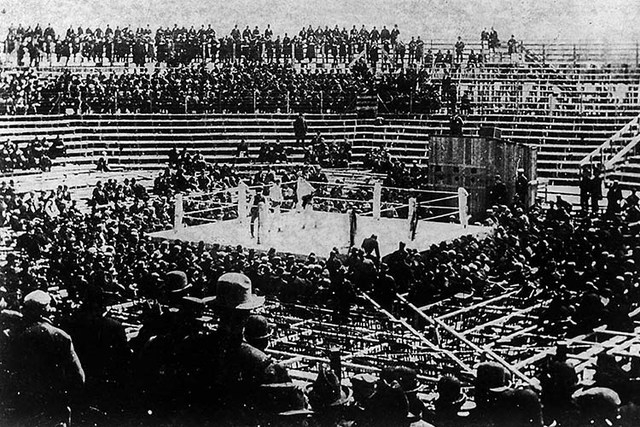State’s first fight made history outside the ring
Nevada’s first prizefight required an act of the Legislature.
With a controversial 20-9 vote and the signature of Gov. Reinhold Sadler in 1897, the state became one of the first to legalize boxing and push back against the nation’s moral code — just as it would later do with legalized gambling, prostitution and quickie divorce.
The bill that some labeled as state-sanctioned depravity cleared the way for Carson City to host what was billed as the “Fight of the Century” on St. Patrick’s Day, March 17, 1897.
To Nevada’s history, the outcome of the fight is secondary: Bob Fitzsimmons, the middleweight champion, won in the 14th round with a technical knockout when he landed a blow to the solar plexus of heavyweight champion “Gentleman” Jim Corbett.
The lasting significance of the bout came from the approximately 6,000 spectators and the international media attention it attracted to a state a mere 33 years old. By some accounts, the event amounted to Nevada’s first attempt at tourism. Richard Moreno, author of “A Short History of Carson City,” said the Nevada Legislature’s changing of state law to allow the fight brought a lot of press coverage to the fledgling state of approximately 40,000 residents.
“It succeeded in what the promoters wanted, which was to fill up rooms in Carson City and Northern Nevada and put the city on the map as a destination,” said Moreno, a former newspaper reporter in Reno now teaching journalism at Western Illinois University.
Dallas gambler and promoter Dan Stuart had been trying to put together the Corbett-Fitzsimmons fight ever since Corbett defeated the legendary former bare-knuckle champion John L. Sullivan in New Orleans in September 1892. According to Corbett’s 1926 autobiography, early plans to hold the fight in Arkansas and Texas were blocked by authorities.
“I decided I would try again for a meeting in some place where the law would not interfere,” Corbett wrote.
Boxing was seen in a far different light at the end of the 19th century. In the five years after Corbett earned the heavyweight belt in 1892, he had an exhibition broken up by police in San Francisco while Fitzsimmons was forced to fight on a barge in the Rio Grande to avoid Texas Rangers and Mexican authorities.
Newspapers and religious leaders condemned the Silver State for allowing the fight, but the New York Times, New York Herald, Boston Globe, San Francisco Examiner, the Chicago Time’s Herald and a host of other publications sent reporters or hired regional writers to cover the event.
According to Leo N. Miletich’s 1994 book, “Dan Stuart’s Fistic Carnival,” newspaper giant William Randolph Hearst paid $10,000 for exclusive access to Fitzsimmons’s pre-fight camp, selling syndicated stories to other newspapers.
Security was overseen by men named Bat Masterson and Wyatt Earp.
A deal was signed to have the fight filmed, resulting in the first known feature sports film and, at more than 90 minutes, one of the longest films of any sort at that time.
Though most of the film has since been lost — only a small portion now exists on YouTube — it’s impact for Nevada and film history cannot be understated.
The fight was shot on 63 mm film by Enchor Rector, the former film partner of Thomas Edison. It premiered two months later at the New York Academy of Music and was later shown in Boston, Chicago, Philadelphia, Pittsburgh, San Francisco and overseas in London and Dublin. The movie earned an estimated $750,000 in fees.
Today, top prizefighters earn tens of millions of dollars for a single bout, and Las Vegas is considered the Fight Capital of the World. The Corbett-Fitzsimmons fight, held eight years before Las Vegas was established as a railroad stop, started it all. On March 17, 1997, the Nevada Legislature passed two resolutions recognizing the 1897 title fight as the start of 100 years of filmmaking and 100 years of boxing in Nevada.
As one of the resolutions put it, “The State of Nevada enjoys a long history of taking risks for suitable gain and legalizing behavior considered ‘scandalous’ in American society.”
Contact Arnold M. Knightly at aknightly@reviewjournal.com or 702-477-3882. Find him on Twitter: @KnightlyGrind.




























